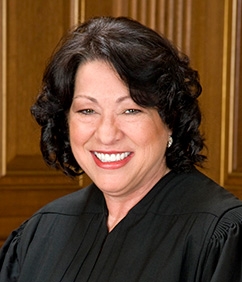Supreme Court Justice Sonia Sotomayor ponders judicial independence in inaugural Katzmann Lecture
On February 9, US Supreme Court Justice Sonia Sotomayor joined Dean Trevor Morrison in a discussion of judicial independence for the inaugural lecture of the Robert A. Katzmann Annual Symposium Series.
The late Robert Katzmann, with whom Sotomayor worked as a fellow judge of the US Court of Appeals for the Second Circuit for a decade and who also overlapped with her when they were students at Yale Law School, selected the subject for the lecture before his death in June 2021. Sotomayor’s comments made clear that the subject of judicial independence remained highly topical against a background of politicized public rhetoric about the federal judiciary and increased polarization of the confirmation process.
Morrison noted that Katzmann had described two different types of judicial independence: decisional independence that allows individual judges to render controversial decisions without fear of reprisal, and institutional independence that permits the court system to do its work without interference from the other two branches of government. Sotomayor agreed with the binary definition proposed by her “brother,” as she warmly referred to Katzmann, and delved into both aspects of judicial independence during her hourlong conversation with Morrison.
Their discussion, which prompted coverage by multiple news outlets and attracted more than 3,000 online viewers, touched on the outsize role of norms—as opposed to law—in preserving judicial independence, the public’s waning trust in judicial integrity, differing views on the advisability of stare decisis and ruling on so-called “social issues,” and ways in which the judiciary might safeguard its independence.
Watch the video of the event:
Selected remarks by Justice Sonia Sotomayor:
“Through our history, every actor in our society has played vital roles in maintaining judicial independence…. Without all sectors of our society understanding the importance of our shared responsibility to protect judicial independence, it will [not] and cannot survive. Now, threats to judicial independence historically have come from different actors for different reasons, but our belief in judicial independence has nonetheless triumphed because other actors have taken up the mantle of defending us. I hope that continues.” (video 21:59)
“I think for the first time in our history, the mantle of judicial philosophy has become tightly interwoven with political parties. For almost all of our history,… political parties rarely discussed the issue of the best way to approach interpretation of the Constitution and statute. That discussion was largely an academic exercise. Now political platforms have adopted the language of judicial doctrines as a way to control outcome in cases, but dangerously, the back and forth that comes in academic debate, that goes into looking at the strengths and weaknesses and costs of different doctrinal approaches, is a nuance the public is not taught by political players. It becomes an issue of slogans rather than the public fully appreciating what it means to approach this in one way or another.” (video 29:41)
“We are far from the times when Supreme Court nominees would receive nearly unanimous approval, even in divided Congresses. And the more partisan the voting becomes, the less belief that the public is likely to have that Congress is making a merits-based or qualifications-based assessment of judicial nominees.” (video 32:57)
“Many academics have pointed to the fact that, in more recent times, circuit courts are reviewing panel decisions in many more en banc reviews…. I come from a circuit which, during my time there, believed that the three judges who heard a case were doing the best job they could…and that even if you disagreed with them, only in extreme circumstances would you ask the entire court of judges to review that decision. And so in my time on the court, maybe one or two en banc proceedings happened. That, on the Second Circuit and other circuit courts, has changed dramatically. Many who view the situation think it has something to do with the partisan nature of the appointment process. I hope not, but it certainly does feed into the public’s uncertainty, and that has a price.” (video 33:26)
“The history of the Court has been filled with justices changing their doctrinal views over time…. I think each judge on every court has to remember that we have an obligation to keep open minds that are willing to change with time and experience. If we don’t show it, people will believe, perhaps wrongly, that we are just political creatures and not independent judges…. Yes, consistency is critical to stability in law, and the public’s perception of judicial fidelity to law and not to outside influence is critical. Yet I believe the public appreciates growth and development in thinking.…. Every litigant who comes into a courtroom has a dream that their arguments will change a judge’s mind. If we destroy that dream, I think we’ve destroyed an important part of people’s faith in the judiciary.” (video 52:14)
Photo credit: Getty Images/Bloomberg
Posted February 22, 2022


